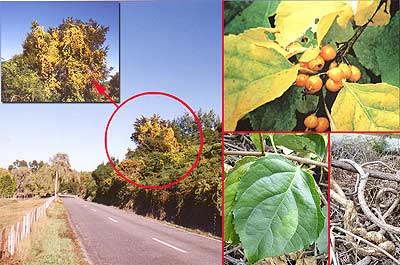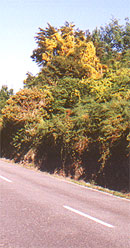Climbing Spindleberry is bad news. And if uncontrolled, will soon appear on a roadside near you. A plant native to China, Japan and eastern Siberia it has become naturalised in New Zealand since around 1985. A long time favorite of floral flower arrangers, and well known for its splendid autumnal colour and profuse small yellow to orange fruit which ripen and split to reveal brilliant red pea sized seeds, a display retained through winter on leafless twigs. They are a bird magnet.
Now is the time to take action because a) this is the time of year when its blaze of yellow colour before leaf drop will give it away as it chokes the life out of the trees it's smothering and b) because there is currently a window of opportunity to stop it establishing in the top of the South Island.

This highly invasive plant has recently been discovered at several locations in the upper South Island; in the Marlborough Sounds, in the Motueka River valley and near Marahau. There will be other yet to be found infestations, as the seeds are attractive and easily spread by birds. The Department of Conservation needs your help in locating these to achieve total eradication, while there is still time.
Celastrus orbiculatus, can smother vegetation up to 12m high and kill host trees. It can form dense impenetrable thickets of woody stems, any untreated roots left in the ground will form suckers, and any stems left behind will layer to form new growth. It likes to climb windbreaks, and will be spread when the hedgerow is pruned.
Also known as oriental bittersweet, the leaves are roundish with an elongated tip typically 5-10cm long. Stems are woody and greyish-brown, often with small knobbly 'warts'. Flowers are pale green and insignificant. It is the bright yellow colour in autumn and the vivid orange and red fruit of winter that will give it away.
Ian Cox is a biodiversity threat ranger with the Department of Conservation in the Motueka offices, and he encourages rural land owners to contact DOC or the local council, rather than treat it themselves initially. "Land owners are in no way liable for control," Ian emphasised, "but it has the potential to be like old mans beard. If we had got that early enough, it wouldn't be the major problem that it is today either."
